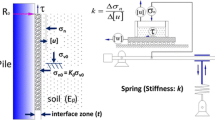Abstract
Slope instability and landslides are frequently triggered during heavy rainfalls in mountainous areas. Geomaterials that are subject to this type of failure normally include coarse grains, which are made by weathering of mother rocks. These materials are called sandy gravel or gravelly sand in soil mechanics, depending upon the amount of gravelly components. This situation suggests a need for laboratory investigations that aim to understand the shear behavior of sand with gravel toward failure. Another feature of this type of failure is a quick rate of slope failure that is reasonably considered as an undrained process of shear distortion. Hence, the present study investigated by means of experiments the undrained shear behavior of sand with gravel. The torsion shear tests on hollow cylindrical specimens concerned the effects of gravel content on the undrained shear behavior. The tests revealed that the effect of gravel content is twofold. When the gravel content is relatively small, the effects of the sandy component are more important. Hence, the relative density of the sandy matrix among gravels has a predominant influence. In this situation, therefore, the overall relative density is a less important index to account for the shear behavior. In contrast, when the gravel content exceeds a threshold value, the amount of gravel comes to have a more predominant influence than the sandy matrix. This is probably because gravel particles start to have contact with each other to form a structural matrix of gravel grains that governs the overall stress–strain behavior. These results were summarized in three-dimensional diagrams that related the strength properties of gravelly sand varying with the density of sand matrix or the density of sand–gravel mixtures as well as the gravel content.












Similar content being viewed by others
References
Chang N, Yey S, Kaufman L (1982) Liquefaction potential of clean and silty-sands. In: Proc 3rd Int Earthquake Microzonation Conf, vol 2, pp 1018–1032
Evans M, Zhou S (1995) Liquefaction behavior of sand-gravel composites. ASCE J Geotech Eng 121(3):287–298
Ishihara K (1993) Liquefaction and flow during earthquakes. Geotechnique 43(3):351–415
Koester J (1994) The influence of fines type and content on cyclic strength in ground failures under seismic conditions. ASCE Publ 44:17–33
Kuerbis R, Negussey D, Vaid Y (1988) Effect of gradation and fines content on the undrained response of sand. In: Van Zyl DJA, Vick SG (eds) Hydraulic fill structures. ASCE, NY, Geotech Spec Publ 21:330–345
Lade P, Yamamuro J (1997) Effect of non-plastic fines on static liquefaction of sands. Can Geotech J 34:918–923
Lin P, Chang C (2002) Damage investigation and liquefaction potential analysis of gravelly soil. J Chinese Inst Eng 25(5):543–554
Sladen J, D’Hollander R, Krahn J (1985) Back analysis of the Nerlerk berm liquefaction slides. Can Geotech J 2:728–739
Thevanayagam S (1998) Effects of fines and confining stress on undrained shear strength of silty sand. J Geotech Geoenviron Eng ASCE 124(6):479–491
Troncoso J, Verdugo R (1985) Silt content and dynamic behavior of tailing sands. In: Proc 11th Int Conf Soil Mech Fnd Eng, vol 3, pp 1311–1314
Vaid Y (1994) Liquefaction of silty soils. In: Prakash S, Dakoulas P (eds) Ground failures under seismic conditions. ASCE Geotech Spec Publ 44:55–56
Yasuda S, Wakamatsu K, Nagase H (1994) Liquefaction of artificially filled silty sands. In: Prakash S, Dakoulas P (eds) Ground failures under seismic conditions. ASCE Geotech Spec Publ 44:91–104
Author information
Authors and Affiliations
Corresponding author
Rights and permissions
About this article
Cite this article
Kuenza, K., Towhata, I., Orense, R.P. et al. Undrained torsional shear tests on gravelly soils. Landslides 1, 185–194 (2004). https://doi.org/10.1007/s10346-004-0023-3
Received:
Accepted:
Published:
Issue Date:
DOI: https://doi.org/10.1007/s10346-004-0023-3






